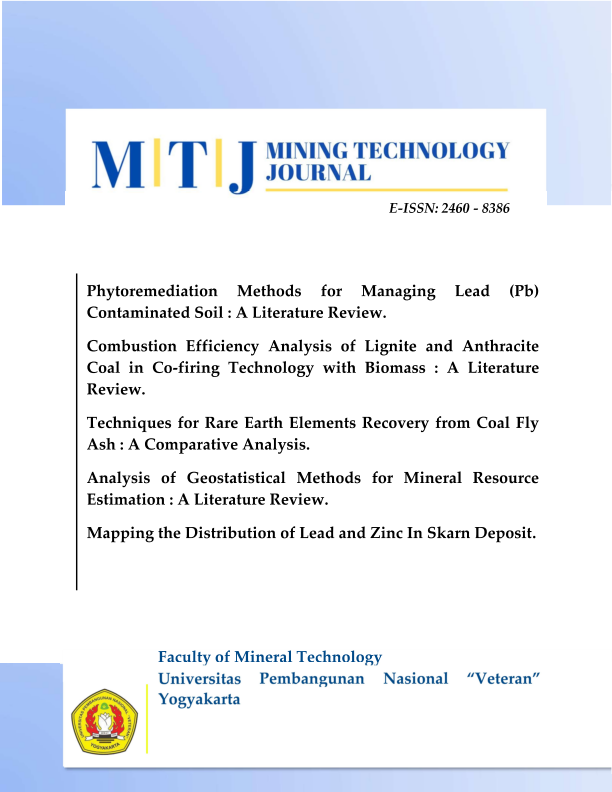Analysis of Geostatistical Methods for Mineral Resource Estimation: A Literature Review
DOI:
https://doi.org/10.31315/mtj.v2i2.14008Abstract
Mineral resource estimation is the process of determining the volume and grade of mineral deposits based on exploration data (SNI 4726:2011). Its objective is to provide a quantitative assessment of the economic potential of mineral deposits. This process involves geological, statistical, and geostatistical principles, while considering data quality, distribution, and deposit characteristics. Geostatistical methods, such as Ordinary Kriging (OK), Indicator Kriging (IK), and Inverse Distance Weighting (IDW), are widely used in resource estimation due to their ability to integrate spatial relationships between data, making them superior to conventional methods. Each method has specific characteristics that make it suitable for certain conditions. OK is well-suited for data with homogeneous distribution, such as nickel, as it can produce accurate estimates with low RMSE. IK is often applied to gold deposits with fluctuating grades and complex spatial relationships. IDW, though simpler, is effective for minerals with homogeneous distributions, such as nickel and iron ore. Previous studies emphasize that the choice of method should consider parameters such as data distribution, type of mineralization, and regional geology. By analyzing the characteristics of these methods, this study evaluates the suitability of OK, IK, and IDW based on the type of mineral and data distribution. This approach aims to support more optimal exploration and management of mineral resources.
References
Amadua, C. C., Owusub, S., Folic, G., Brakoc, B. A., & Abanyied, S. K. (2022). Comparison of ordinary kriging (OK) and inverse distance weighting (IDW) methods for the estimation of a modified palaeoplacer gold deposit: a case study of the Teberebie gold deposit, SW Ghana. Group, 250, 700. Doi: http://doi.org/10.26480/mjg.01.2022.19.28
Antunes, I. M. H. R., & Albuquerque, M. T. D. (2013). Using indicator kriging for the evaluation of arsenic potential contamination in an abandoned mining area (Portugal). Science of the Total Environment, 442, 545-552. https://doi.org/10.1016/j.scitotenv.2012.10.010
Bargawa, W. S. (2009). Application of Non-Linear Kriging in Estimating Gold Ore Grade. JIK TEKMIN, 22(2), 101-114. http://eprints.upnyk.ac.id/id/eprint/13222
Bargawa, W. S., & Amri, N. A. (2016, February). Mineral resources estimation based on block modeling. In AIP Conference Proceedings (Vol. 1705, No. 1, p. 020001). AIP Publishing LLC. http://doi/10.1063/1.4940249.
Bargawa, W. S., & Amri, N. A. (2021). Perbandingan Metode Geostatistik dari Hasil Estimasi Sumberdaya Nikel Laterit. http://journal.itny.ac.id/index.php/ReTII
Carvalho, D., & Deutsch, C. V. (2017). An overview of multiple indicator kriging. Geostatistics Lessons, 7. http://geostatisticslessons.com/lessons/mikoverview
Conoras, W. A., & Djin, A. (2021). Pemodelan Estimasi Sumberdaya Endapan Emas (Au) Daerah Loloda Menggunakan Metode Inverse Distance Cube (ID3) Dan Ordinary Kriging (OK). DINTEK, 14(2), 82-95. https://jurnal.ummu.ac.id/index.php/dintek/article/view/950
Deutsch, C. V., & Journel, A. G. (1998). GSLIB: Geostatistical software library and user’s guide (p. 369). Oxford University Press.
Indonesia, S. N. (2011). Guidelines for Reporting Mineral Resources and Reserves. SNI, 4726, 2011. https://perhapi.or.id/doc/sni-4726.pdf
Isaaks, E.H. and R.M. Srivastava., (1989), Applied geostatistics, Oxford University Press, New York.
Journel, A. G. (2003). Multiple-point geostatistics: a state of the art. Unpublished Stanford Center for Reservoir Forecasting paper. https://pangea.stanford.edu/departments/ere/dropbox/scrf/documents/reports/16/SCRF2003_Report16/SCRF2003_Andre_Journel.pdf
KCMI, (2011), Indonesian Code for Reporting Exploration Results, Mineral Resources, and Mineral Reserves, Indonesian Mineral Reserves Committee (KCMI). https://perhapi.or.id/doc/sni-4726.pdf
Kurniawan, A. R., & Amri, N. A. (2019). Estimation of Gold Resources Using Ordinary Kriging and Indicator Kriging Methods at Pit X, PT Indo Muro Kencana, Tanah Siang District, Murung Raya Regency, Central Kalimantan. http://journalsttnas.ac.id/online/index.php/ReTII
Matheron, G., (1963). Principles of geostatistics. Econ Geol 58: 1246-1266.
Nugraha, A. P. (2020). Comparison of Geostatistical Methods Kriging and Co-Kriging Using Point Kriging Estimation. ReTII, 177-181. https://journal.itny.ac.id/index.php/ReTII/article/view/2013/1071
Purnomo, H. (2021). Mapping the Distribution of Iron Grades in Nickel Laterite Deposits Using Indicator Kriging and Ordinary Kriging Interpolation Methods. PROMINE, 9(1), 29-36. https://doi.org/10.33019/promine.v9i1
Puspita, W. (2013). Geostatistical Data Analysis Using the Ordinary Kriging Method (Doctoral Dissertation, Universitas Pendidikan Indonesia. http://repository.upi.edu/id/eprint/4122
Riyadi, H., Warmada, I. W., Titisari, A. D., & Idrus, A. (2023). Estimation of Base Metal Skarn Resources Using the Ordinary Kriging Geostatistical Method in Block A Ruwai, Lamandau Regency, Central Kalimantan Province. ReTII, 18(1), 802-810. https://journal.itny.ac.id/index.php/ReTII/article/view/4593
Rizky, M., & Yulhendra, D. (2022). Estimation of Iron Ore Resources Using Inverse Distance Weighted and Ordinary Kriging Methods at PT. KUATASSI, Solok Regency, West Sumatra. Journals Mining Engineering: Bina Tambang, 7(1), 96-106. https://ejournal.unp.ac.id/index.php/mining/article/view/117752/106678
Rafsanjani, M. R. (2016). Estimation of Lateritic Nickel Ore Resources Using the IDW Method in Southeast Sulawesi Province. Jurnal Geomine, 4(1). DOI: 10.33536/jg.v4i1.39
Safrudin, R., & Conoras, W. A. (2021). Estimation of Lateritic Nickel Resources Using Ordinary Kriging Geostatistical Method at PT Dharma Rosadi Internasional, Central Halmahera Regency, North Maluku Province. Jurnal GEOMining, 2(1), 38-48. https://doi.org/10.33387/geomining.v2i1.3921
Thamsi, A. B., Ainunnur, I., Anwar, H., & Aswadi, M. (2023). Estimation of Nickel Resources Using the Inverse Distance Weight Method at PT Ang and Fang Brothers. JGE (Journal of Geophysical Exploration), 9(1), 5-17. https://doi.org/10.23960/jge.v9i1.235
Zhexenbayeva, A., Madani, N., Renard, P., & Straubhaar, J. (2024). Using multiple-point geostatistics for geomodeling of a vein-type gold deposit. Applied Computing and Geosciences, 23, 100177. https://doi.org/10.1016/j.acags.2024.100177
Downloads
Published
Issue
Section
License
Copyright (c) 2025 Mining Technology Journal

This work is licensed under a Creative Commons Attribution-NoDerivatives 4.0 International License.

